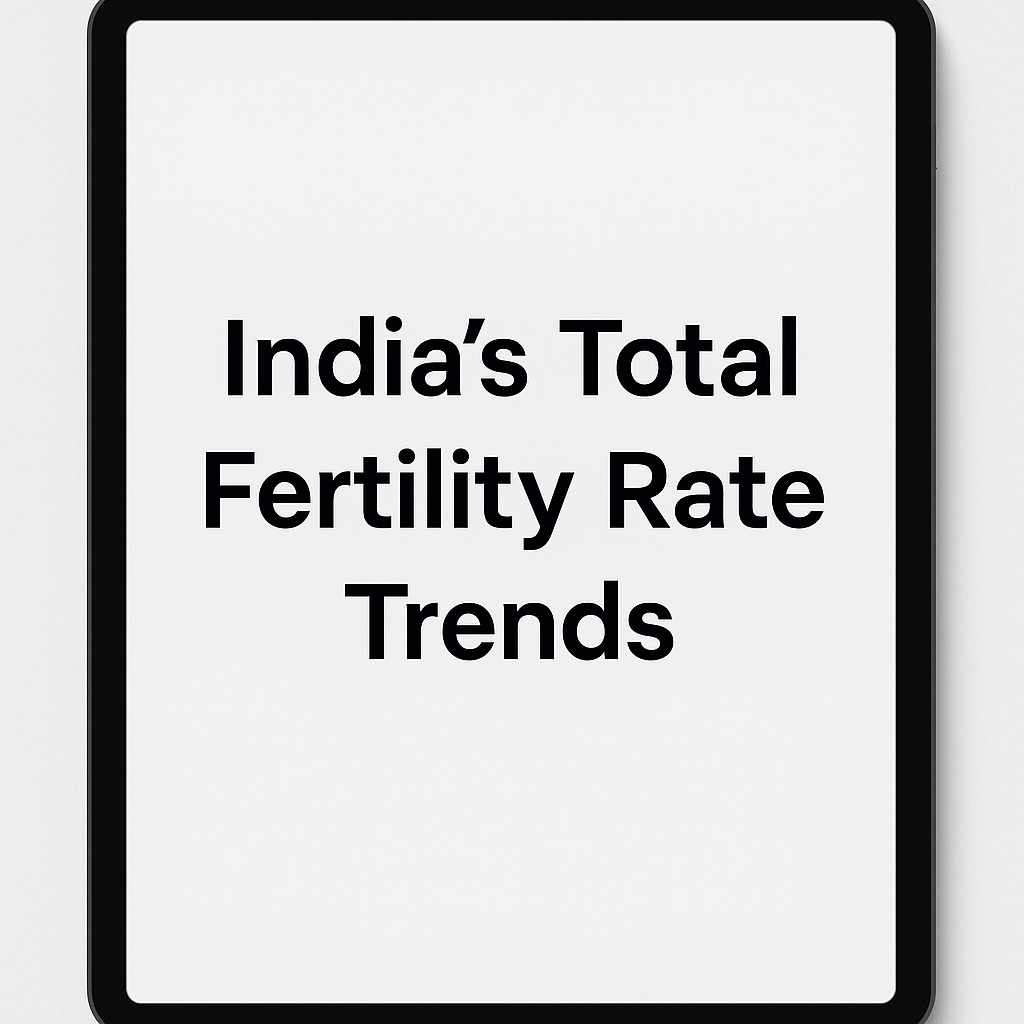
🧭May 21, 2025, Post 2: The Silent Curve: India’s Fertility Trends and Regional Contrasts | High Quality Mains Essay | Prelims MCQs
The Silent Curve: India’s Fertility Trends and Regional Contrasts

🗓️Post Date: May 21, 2025
📘 Thematic Focus: GS1 – Population and Society / GS2 – Health Policy / GS3 – Human Development
🌱 Intro Whisper
In the rhythm of a nation’s future lies the quiet count of its children. India’s Total Fertility Rate tells a tale not just of numbers, but of choices, access, and the human story of growth and restraint.
📌 Key Highlights
- Total Fertility Rate (TFR) – India’s Status:
According to the SRS 2021 Report, India’s TFR remains at 2.0, below the replacement level of 2.1. This confirms population stabilization trends nationwide. - Definition:
TFR measures the average number of children a woman would have during her reproductive age (15–49), based on age-specific fertility rates. - Data Source – Sample Registration System (SRS):
The largest demographic survey in India, covering approx. 84 lakh people across states and UTs. - Fertility Indicators in SRS Report:
– Crude Birth Rate (CBR): 19.3 (per 1,000 people) in 2021
– General Fertility Rate (GFR) and Age-Specific Fertility Rates (ASFRs) also recorded
– CBR is declining at 1.12% annually since 2016 - Regional Variation in TFR:
– Highest: Bihar (3.0), Madhya Pradesh
– Lowest: West Bengal and Delhi (1.4), Kerala, Tamil Nadu
– High TFR = pressure on resources
– Low TFR = concerns of ageing population, shrinking workforce, and changing family norms - Implications for Policy:
– High TFR states need improved education, women’s healthcare, and family planning access
– Low TFR states must prepare for elderly care, labour market reforms, and pro-natal incentives
📊 Concept Explainer – What is Total Fertility Rate (TFR)?
Total Fertility Rate is a summary measure of fertility, estimating the average number of children born to a woman over her lifetime.
It provides a snapshot of reproductive behavior and is used to:
– Monitor population stability
– Forecast dependency ratios
– Design public health and economic policies
Replacement-level fertility is 2.1 — the rate at which a population exactly replaces itself from one generation to the next, assuming no migration.
🗺️ GS Paper Mapping
- GS Paper 1:
– Population and related issues
– Regional variations in development - GS Paper 2:
– Health indicators
– Human development and policy interventions - GS Paper 3:
– Demographics and future economic planning
– Labour force dynamics
🌌 A Thought Spark — by IAS Monk
“A child born is not just a statistic; it is a story of a home, a hope, and a nation’s horizon. The fertility curve rises and falls, but the soul of society must balance between too much and too little.”
High Quality Mains Essay For Practice :
Word Limit 1000-1200
India’s Total Fertility Rate: A Demographic Turning Point
India’s Total Fertility Rate (TFR) has reached a demographic milestone. As per the Sample Registration System (SRS) Statistical Report 2021, India’s TFR has stabilized at 2.0, a level below the replacement threshold of 2.1. This shift, while statistically encouraging, unveils a complex and uneven fertility transition across Indian states, with profound implications for public policy, population dynamics, gender equity, and long-term development planning.
Understanding TFR: A Barometer of Societal Progress
TFR is a critical demographic indicator that estimates the average number of children a woman would have over her reproductive lifespan (15–49 years). A TFR of 2.1 is globally considered the replacement level—where a population exactly replaces itself from one generation to the next in the absence of migration. Falling below this level signals the onset of population decline and aging, unless mitigated by inward migration or policy corrections.
India’s national average of 2.0 reflects decades of population stabilization efforts, from family planning programs introduced during the Green Revolution to more recent initiatives focused on reproductive health and women’s education. Yet, this national average hides a deep demographic dualism: while southern and urbanized states have moved into sub-replacement fertility, large parts of north-central India still experience high fertility rates.
Demographic Divergence: A Tale of Two Indias
The 2021 SRS report highlights stark contrasts. Bihar, for example, leads the fertility chart with a TFR of 3.0, followed by Uttar Pradesh (2.4) and Madhya Pradesh (2.3). These states, characterized by rural dominance, low female literacy, early marriages, and patriarchal norms, contrast sharply with West Bengal (1.4), Delhi (1.4), and Tamil Nadu (1.5)—which exhibit indicators of demographic maturity, including smaller family norms, later marriages, and higher contraceptive usage.
Such disparities are not accidental. They reflect the interplay of education levels, health access, urbanization, women’s autonomy, and state capacity. For example, Tamil Nadu’s early emphasis on health infrastructure, women’s literacy, and decentralization helped it transition earlier, whereas in Bihar, entrenched social hierarchies and weak governance continue to slow demographic transition.
Historical Context: From Baby Boom to Balanced Growth
India’s journey from a TFR of 5.9 in the 1950s to 2.0 today is a testament to policy evolution. The National Population Policy 2000 set clear objectives to stabilize population by 2045. Initiatives like Janani Suraksha Yojana, Mission Parivar Vikas, and the National Health Mission (NHM) promoted institutional deliveries, reproductive health, and access to contraception.
The introduction of ASHA workers, community mobilization strategies, and the increasing demand for smaller families due to economic aspirations helped in reducing birth rates. However, while the policy focus succeeded nationally, the regional execution and socio-cultural adaptability remain uneven.
Why Fertility Still Varies? Socio-Economic Determinants
Fertility is not merely a function of biology—it is a mirror to social opportunity, equity, and empowerment. High fertility correlates strongly with:
- Low female literacy and school dropout rates
- Early and forced marriages, especially in rural belts
- Poor access to contraception and family planning
- High infant mortality, which encourages larger families as insurance
- Cultural preference for male children
- Lack of awareness about reproductive rights
In contrast, regions with better public health, education for girls, and economic opportunities witness rapid fertility decline. Importantly, women’s decision-making power—both in the household and community—is the strongest predictor of fertility behavior.
Economic and Social Implications of Low and High TFR
A low TFR is often lauded for reducing pressure on resources and public services. However, it brings new challenges:
- Aging populations with increasing healthcare and pension burdens
- Shrinking labor force, especially in southern states
- Emptying classrooms and reduced school enrollments
- Potential loss of demographic dividend if productivity does not rise
On the other hand, high TFR regions face the classic problems of youth bulge: unemployment, poor health outcomes, and intergenerational poverty.
India now experiences a unique phenomenon: a youth-heavy North and an aging South—calling for coordinated interstate resource sharing, migration management, and tailored public service delivery.
Learning from Global Examples
Globally, countries like Japan, South Korea, and Italy offer cautionary tales of sub-replacement fertility. Despite economic prosperity, they struggle with population decline, elder care, and low birth incentives. South Korea, with a TFR of 0.78, is investing billions in child subsidies and parental leave reforms—yet failing to reverse the trend.
India must learn from this: while declining fertility is a success, it must avoid a policy vacuum that allows the transition to overshoot into irreversible decline. Simultaneously, states with persistently high fertility must not be left behind, or India risks two demographic destinies—one aging, one overburdened.
Policy Recommendations: Bridging the Demographic Divide
- Targeted Fertility Transition Plans for high-TFR states like Bihar and U.P.
- Universal access to contraception and menstrual health products
- Incentivize girls’ secondary education and vocational training
- Curb child marriage through legal enforcement and community programs
- Expand Mission Parivar Vikas and make it culturally adaptive
- Support interstate labor mobility frameworks to balance demographic demand
- Initiate elder care and pension reforms in low-TFR states
Importantly, family planning must remain voluntary, rights-based, and devoid of coercion.
Conclusion: A Demographic Destiny in Motion
India’s demographic journey is now in a delicate phase. While the TFR milestone indicates progress, it demands alertness, compassion, and equity. A mere celebration of numbers is insufficient—what matters is the well-being of mothers, agency of women, and inclusion of all regions in India’s development story.
Fertility is not just about population control—it is about human capability, choice, and societal maturity. The challenge is to ensure that no woman is forced into motherhood, that no child is denied opportunity, and that no region is left behind.
“A population doesn’t shrink or grow by numbers alone — it expands or contracts by the dignity and freedom its citizens experience.”
India must shape its population policies not in the shadow of fear, but in the light of justice.
Target IAS-26: Daily MCQs :
📌 Prelims Practice MCQs
Topic:
MCQ 1 – Type 1: How many of the following statements are correct?
Consider the following statements about Total Fertility Rate (TFR):
1. TFR measures the number of children born per 1000 women annually.
2. A TFR below 2.1 indicates potential population decline in the long run.
3. India’s TFR as per SRS 2021 is 2.0.
4. Delhi has one of the highest TFRs in the country.
How many of the above statements are correct?
A) Only two
B) Only three
C) All four
D) Only one
🌀 Didn’t get it? Click here (▸) for the Correct Answer & Explanation
✅ Correct Answer: B) Only three
🧠 Explanation:
1. ❌ False – TFR is an average number of children per woman, not per 1000 women annually.
2. ✅ True – A TFR below 2.1 means a population cannot replace itself naturally.
3. ✅ True – India’s TFR is 2.0 as per SRS 2021.
4. ❌ False – Delhi has one of the lowest TFRs at 1.4.
MCQ 2 – Type 2: Two-Statement Check
Consider the following statements:
1. Bihar has the highest Total Fertility Rate among Indian states.
2. The Sample Registration System (SRS) is India’s largest demographic survey.
A) Only 1 is correct
B) Only 2 is correct
C) Both are correct
D) Neither is correct
🌀 Didn’t get it? Click here (▸) for the Correct Answer & Explanation
✅ Correct Answer: C) Both are correct
🧠 Explanation:
1. ✅ True – Bihar’s TFR is 3.0, the highest in India.
2) ✅ True – SRS covers nearly 84 lakh individuals, making it India’s largest demographic survey.
MCQ 3 – Type 3: Which of the following statements are correct?
Which of the following states have a Total Fertility Rate (TFR) below the replacement level of 2.1?
1. Maharashtra
2. Tamil Nadu
3. Uttar Pradesh
4. West Bengal
Select the correct answer using the code below:
A) 1, 2, and 4 only
B) 2 and 3 only
C) 1, 3, and 4 only
D) All four
🌀 Didn’t get it? Click here (▸) for the Correct Answer & Explanation
✅ Correct Answer: A) 1, 2, and 4 only
🧠 Explanation:
•1) ✅ True – Maharashtra’s TFR is around 1.8, below replacement.
•2) ✅ True – Tamil Nadu’s TFR is around 1.5.
•3) ❌ False – U.P. has a TFR of 2.4, above the replacement level.
•4) ✅ True – West Bengal has a TFR of 1.4.
MCQ 4 – Type 4: Direct Factual Question
What is the replacement level Total Fertility Rate (TFR) commonly accepted by demographers for stable population growth?
A) 1.5
B) 2.0
C) 2.1
D) 2.3
🌀 Didn’t get it? Click here (▸) for the Correct Answer & Explanation.
✅ Correct Answer: B) Adolf Goetzberger and Armin Zastrow
🧠 Explanation:
Correct Answer: C) 2.1
• ✅ Correct – A TFR of 2.1 is widely accepted as the replacement level to maintain a stable population across generations.


















